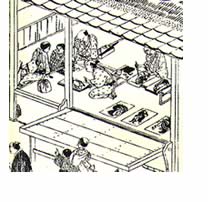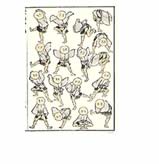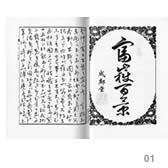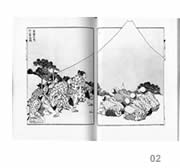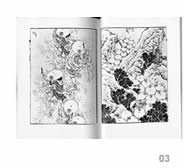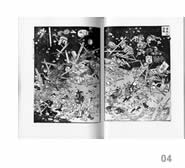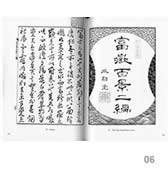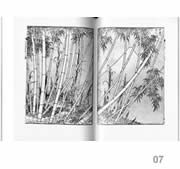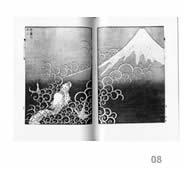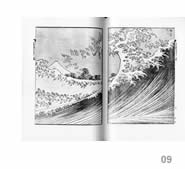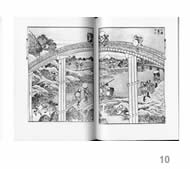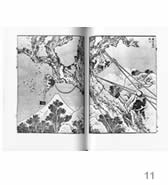NOTES
ON THE PLATES SELECTED
TOP
ROW
01 A typical
deployment of studies in the pages of the MANGA
02 From
Thirty Six Views of Fuji , "Hodogaya on the Tokaido Trunk Road"
25 x 36.
03 Detail
of Ikei's wood engraving of a view of a print shop in Japan from which
prints were sold. c1797
ONE
HUNDRED VIEWS OF MOUNT FUJI - SELECTED PLATES
01 Preface
and Titlepage (Inner cover)
02 The
Appearence of Mount Fuji in the Fifth Year of Korei, the moment
when the mountain was created from the displacement of Lake Biwa - the
power of the cration is such that it breaks the allotted frame of the
print.
03 right,
the Opening of Fuji, and left Sliding Down.
The ascent of pilgrims and their descent through the shifting sands,
a cinematic change of camera position and scale.
04 The
Appearence of Hoeizen, a known volcanic explosion 53 years
before Hokusai's birth. The slow pacing of the narrative sudedenly distegrates
into chaos.
05
Fuji from a Pine Mountain. Smith records characteristic matsutake
mushrooms in the basket carried by one figure.
06 Title
Page (inside front cover) and right the explanatory Preface
07 Fuji
in a Bamboo Grove.
08 Fuji
and Ascending Dragon. The graphic formula for water changes
gradually to cloud and mist patterns.
09 Fuji
at Sea. The composition builds on the right and is about to
break across the double pages, in the way the book is read. The Great
Wave theme.
10 Fuji
with Seven Bridges in one view. A graphic challenge of spatial
relations and visual jokes.e.g. "How many bridges can you find
in this composition?" Smith notes an advertisement for a Hokusai
print that boasted a hundred bridges in the one composition.
11 Fuji
in the Totomi Mountains. An exercise in point of view and various
contrasts of scale. Sawyers are trimming and treating a large tree.
12 Fuji
from Suidobashi, on the first page and a sudden change of scale
for Fuji seen through a spider's web. Smith notes Hokusai's regular
cavalier attitude to topographical accurcay, here in the treatment of
the river.
13 Fuji
at Torigoe on the right, a massive artistic here in the depiction
of the Orrery and signifying the building of an observatory at the town,
moving to Fuji over a waterfall with a woodcutter and
family passing near.
14 Fuji
behind a net, and left, Fuji under a bridge.
15 Left,
Fuji from Rakanjii Temple with a huge and complex and
left, Fuji from Senzoko , a double page spread bouncing
one composition against the other
 A SELECTION FROM THE THAMES AND HUDSON 3 VOLUME SET OF THE MANGA (3 galleries) A SELECTION FROM THE THAMES AND HUDSON 3 VOLUME SET OF THE MANGA (3 galleries)
 ROYAL ACADEMY EXHIBITION 1992 ROYAL ACADEMY EXHIBITION 1992
 BRITISH LIBRARY, The Great Picture Book of Everything BRITISH LIBRARY, The Great Picture Book of Everything
 BRITISH MUSEUM, Beyond the Great Wave BRITISH MUSEUM, Beyond the Great Wave
 THE
BIGGEST PICTURE ON RECORD THE
BIGGEST PICTURE ON RECORD
 THE
WAVES AT KANAGAWA, c1823-9 26x37cms THE
WAVES AT KANAGAWA, c1823-9 26x37cms
|
Hokusai;
Sequence and Perspective in Book Illustration.
"At fifteen I set my heart on learning. At thirty, I was firmly established.
At forty I had no more doubts. At fifty, I knew the will of Heaven. At
sixty, I was ready to listen to it. At seventy, I could follow my heart's
desire without transgressing what was right."
"From the age of six I had a penchant for copying the form of things,
and from about fifty, my pictures were frequently published ; but until
the age of seventy, nothing that I drew was worthy of notice. At seventy-three
years, I was somewhat able to fathom the growth of plants and trees, and
the structure of birds, insects and fish. Thus when I reached eighty years,
I hope to have made increasing progress, and at ninety to see further
into the underlying principles of things, so that at one hundred years
I will have achieved a divine state in my art, and at one hundred and
ten, every dot and stroke will be as though alive."
One
Hundred Views of Mount Fuji, (3 vols. 1834- 5, c1949), Fugaku
Hyakkei, signed Zeen Hokusai Iitsu Gakyorojin.
This lecture explores the ways in which Hokusai deployed a series of images
of Mount Fuji in a book of over a hundred wood engravings. Rather than
present a narrative as we would understand it, he begins with a short
sequence of images setting the scene and then deploys two sets of variables
into a sort of web of possibilities.
Mount Fuji is 10,000 years old, the result of the third volcanic explosion
at the site. It covers two previous Fujis. The present Fuji is still active
with a crater to the right hand side of the outline when viewed from Shizuoka
Peninsula. It is 12.388 feet above sea level and at the top is a shrine
devoted to the spirits of medieval samurai.Mount Fuji was depicted by
Hokusai in The Thirty-six Views of Mount Fuji (1831) and apart from other
artists and print makers, by Hiroshige The Fifty Three Stations of the
Tokaido .
Hokusai (1760 - 1849) obscure peasant origins, maybe from peasant family,
apprenticed early to a wood engraver, and began to change his name (30
odd); 1778 pupil of Katsukawa Shunsho at the time of the apogee of the
ukiyo-e, the multi-colouredf print (actresses, landscapes, animals etc)1790's
studied Chinese paintings, greatly influenced by Dutch prints. Main work
done after 1800. Hokusai Manga started 1815; 1831, Thirty
Six Views of Mount Fuji, and in 1834 One Hundred Views
of Mount Fuji.
CONSIDERATIONS
1. The Object , a mountain
1.1 shape contour, outline
1.2 landscape
1.3 air
1.4 natural growth
1.5 water
1.6 human beings
1.7 architecture
2. The Book
2.1 sequence of pages
2.2 the paper
2.3 the single page
2.4 the double page
2.5 margin/frame
2.6 style
2.7 pattern
 ..... THIRTY SIX VIEWS OF MOUNT FUJI ..... THIRTY SIX VIEWS OF MOUNT FUJI
BOOKLIST
Henry D. Smith Hokusai One Hundred Views of Mt.Fuji,
Brazillier NY 1988
Jack Hillier The Art of Hokusai in Book Illustration
Sotheby Parke Burnet 1980 Univ.of Calif Press
J.Hillier Hokusai Drawings Phaidon London 1968
Hillier and Smith Japanese Prints,300 years of albums and books
Brit.Museum 1980
Joe Earle (ed) Japanese Art and Design Vict & Albert
London 1986
William Watson The Great Japan exhibition , ex.catal.
Royal Academy . London 1981/2
Victoria Manthorpe(ed) The Japan Diaries of Richard Gordon Smith
Viking Penguin, Harmonds. 1986
|





